This post may contain affiliate links, which means I'll earn a small commission if you purchase something through these links. You won't pay any extra; instead, you'll be helping Aloha With Love to thrive. Thank you! Learn more.
--
Raising walking catfish (Clarias Fuscus) in my aquaponic systems was an experience. Like tilapia, they’re a very hardy fish, but because of their unique airbreathing abilities and characteristics, there were some major differences in the way I cared for them until harvest. I’m sure there’s somebody out there who is curious about raising and harvesting walking catfish in their aquaculture or aquaponic systems because they’re pretty easy to get (although prohibited and/or illegal in many states). They are very strong and adaptable, which means they’re considered as pests and invasive species in most places.
I hope this helps you make your decision of whether or not to try and raise them yourself!
Aloha with love,
Amy
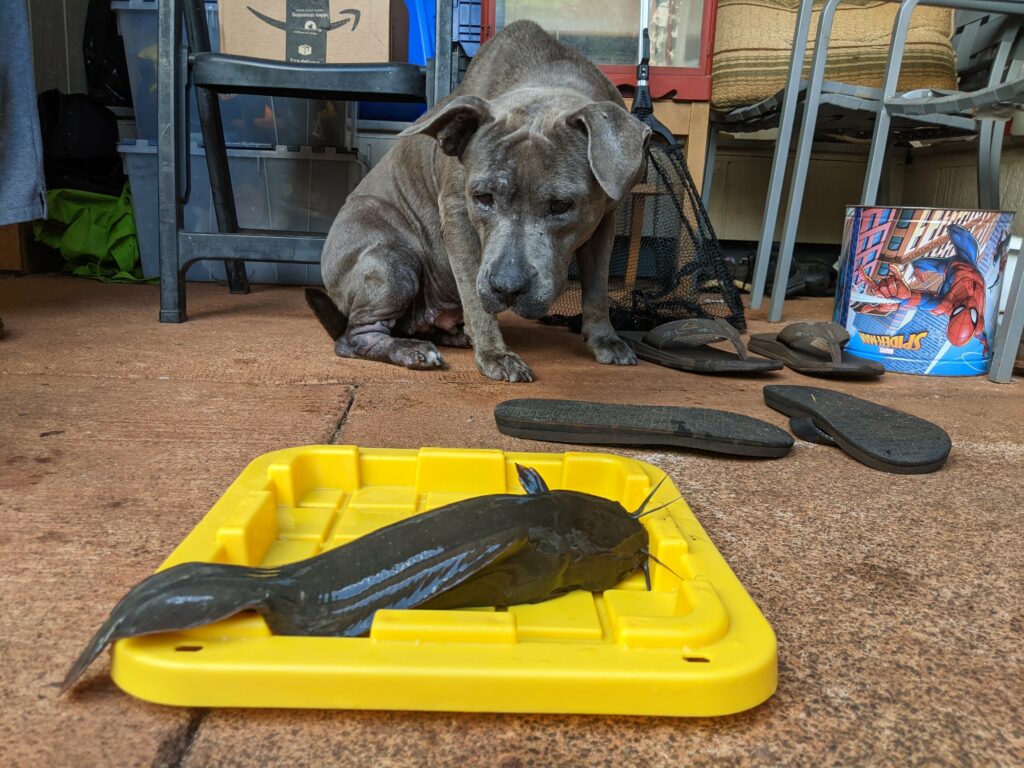
Pros & cons
PROS:
- They grow extremely fast: At 4 months, a couple of them were already 12-inches long. By 6 months, all of them were 12-inches long.
- They taste good: If you have a good recipe for them or know someone who can prepare these, then walking catfish are great. They are a staple in Thailand and my Mom’s Thai friend knows how to cook them. Unfortunately, recipes for this type of fish are hard to find in English, so if you know of one let me know!
- They don’t have scales: Scaling fish can be messy, so it’s a pro that these guys don’t have scales. You don’t have to skin them either (unlike the more common channel catfish). Their skin is thin and tender and can be eaten, but they are slimy.
- They can breathe air like us: Unlike most other fish, walking catfish gills are veiny looking and they can breathe oxygen in the air and in the water. So if your pump dies or the electricity goes out, your walking catfish will still be alive when you check in on them the next day.
- Extremely hardy: In terms of adaptability, they’re on par with tilapia in my opinion if not more so. They have a great survival rate, can deal with sudden water changes, and are extremely hardy.
- Daisy loves them: My dog Daisy is on a raw diet and I froze a bunch of these catfish and she eats them as a meal every so often. She loves them and will eat everything: meat, bones, organs, and all.
CONS:
- They eat a lot: Walking catfish eat A LOT. For every handful of of fish food I gave to my tilapia, the walking catfish needed three.
- They eat each other: If you have the bright idea of trying to lower their food intake, don’t be surprised when they start to attack each other. You can tell which one is being bullied because their skin will be ripped off with white abrasions all over their body. I once woke up to a walking catfish skull floating in the water completely picked clean.
- They poop a lot: Most of us know what fish poop looks like. It’s long, stringy, and floats around in the water. Walking catfish eat a lot, don’t seem to process much of it, and poop out heavy sediment. This quickly filled up my filter and at one point I was cleaning my filters at least once a week. Not fun.
- Their “walking fins” will make you bleed: Their side fins have a small sharp bone that allows them to lift and drag/wiggle their bodies, which is where they get their nickname from. When you handle them, you’re bound to get poked because they’ll just wriggle and jump. It’s also difficult to get a good grasp on them since they’re so slimy.
- They’re difficult to kill/harvest: Whenever you’re raising any kind of animal to eat, you want to give them a swift kill when you harvest them so they feel as little pain as possible. Because the walking catfish can breathe without water for so long, they’re still “very alive” by the time you get them to the cutting board. Their broad skull is very hard and it took 2 or 3 hits against the head to really knock them out.
- They’re boring to watch: Other than at meal times, they sort of enter a coma and just sink to the bottom of the tank and don’t move. I thought they were all dead at first! If you’re thinking to put these fish in a pond or fish tank for aesthetic reasons, think again.
Walking catfish in Hawaii
When I was first planning out my aquaponics systems, tilapia was the natural choice as they thrive in Hawaii’s climate and can take a lot of stress such as pH changes and ammonia in the water. Of course, you want to decrease these stressors as much as possible, but for anyone entering into aquaponics, they’re a great fish to start off with. I was interested in raising other fish species in my systems and found out that you can catch channel catfish in Lake Wilson! So I did a search for catfish online and found someone selling fingerlings. I bought 20, received almost 40, and popped them into the tank. I was told by the seller that they needed to be fed 3 times a day or they’d start to eat each other. Once they started to get a little larger I fed them in the morning and night (same as my tilapia).
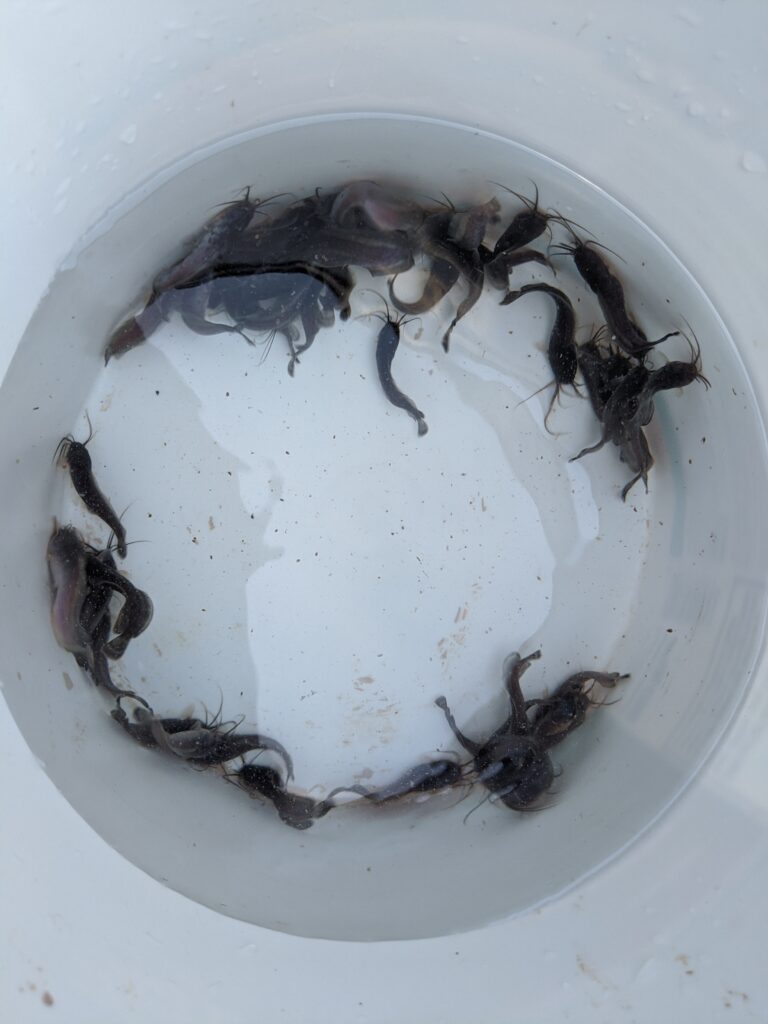
It wasn’t until later after a bit more research that I thought “hmm…are these even allowed in Hawaii?” I knew that the catfish I had were “walking catfish” of the Clariidae family (aka airbreathing catfish). Around the world, they’re known as pests, invasive species, and are illegal in many US states. I couldn’t find much information about them here in Hawaii (although they were brought over at some point), so I sent an email off to the Aquatics Department of DLNR. The reply I received was that “all catfishes in the family Clariidae except for Clarias Fuscus are on the prohibited animal list.” Here’s a list of prohibited animals that was included in the email reply.
The problem for me though was that when I compared the Clarias Fuscus to other catfish in the same family such as the Clarias Batrachus, I couldn’t tell the difference between the two. Both are dark grey and there is so little information about either of them in English that there’s no way I can know for sure that the fish I had were legal. Since Hawaii does have a history with Clarias Fuscus though, I gave the seller the benefit of the doubt and am still crossing my fingers that the catfish I raised were indeed Clarias Fuscus. If there’s anyone out there who can confirm this for me, please let me know!
About walking catfish
Walking catfish are originally from Southeast Asia and they’re known for eating out the local fish species. In particular, they’ve made their presence known in Florida where they’ve “walked” into ponds during rainstorms and you can see them out on the roads, sidewalks, and grass squirming and wriggling their way to fresher pastures.
The best source for raising and cooking walking catfish are the vlogging YouTube videos by Life in Thailand. He measures his catfish and you get to see them at different ages and sizes, so it’s a good source to see walking catfish in action. Here’s a link to his catfish videos playlist.
Age and size
Here are some pictures and a timeline of dates, sizes, and measurements of the walking catfish I raised so you can compare and contrast how fast these guys grow:
- August 30, 2020: Purchased 38 2-inch fingerlings.
- October 6, 2020: A month later, the catfish were 4-inches long.
- November 1, 2020: Two months after purchase, the catfish were 6-inches long. I moved them to my IBC aquaponics system because my smaller system (55-gallon fish tank) was becoming too crowded and they were swimming into each other.
- December 4, 2020: 3 months after purchase, the catfish were 8 to 9-inches long and you can start to tell which ones are going to grow faster than the others. As the fish grow, they produce more waste and both the water and filter gets murky and dirty faster.
- February 28, 2021: 6 months after purchase, the catfish were about 11 to 12-inches long. I had my first harvest here and the water in their tank was so dark that I couldn’t see past a few inches from the top of the water.
- May 8, 2021: 9 months after purchase, the catfish are between 12 and 13-inches long. Their growth in length has slowed, but their girth has widened a little. The females were obviously more fatter and larger than the males. Many of them were also carrying eggs.
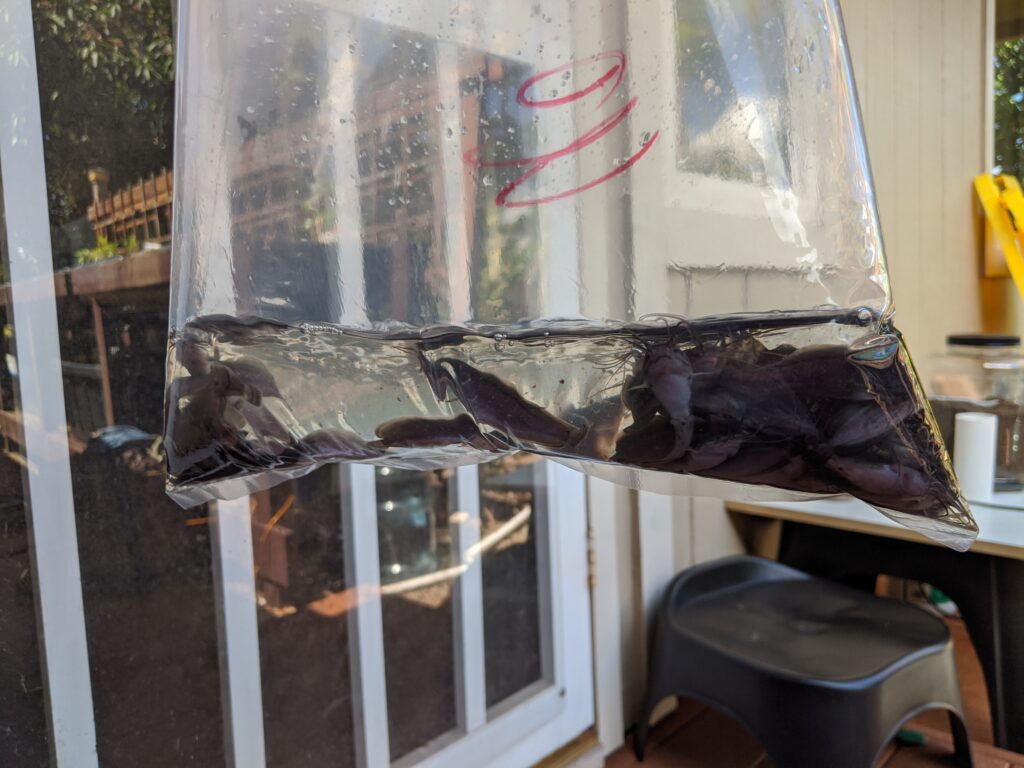
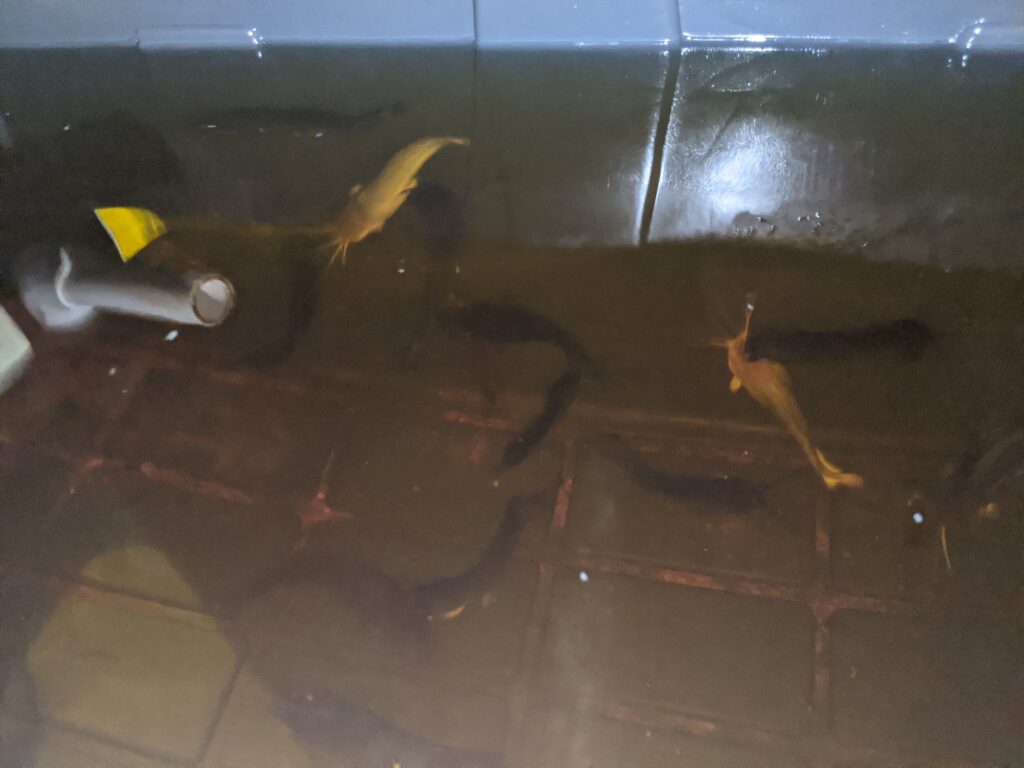
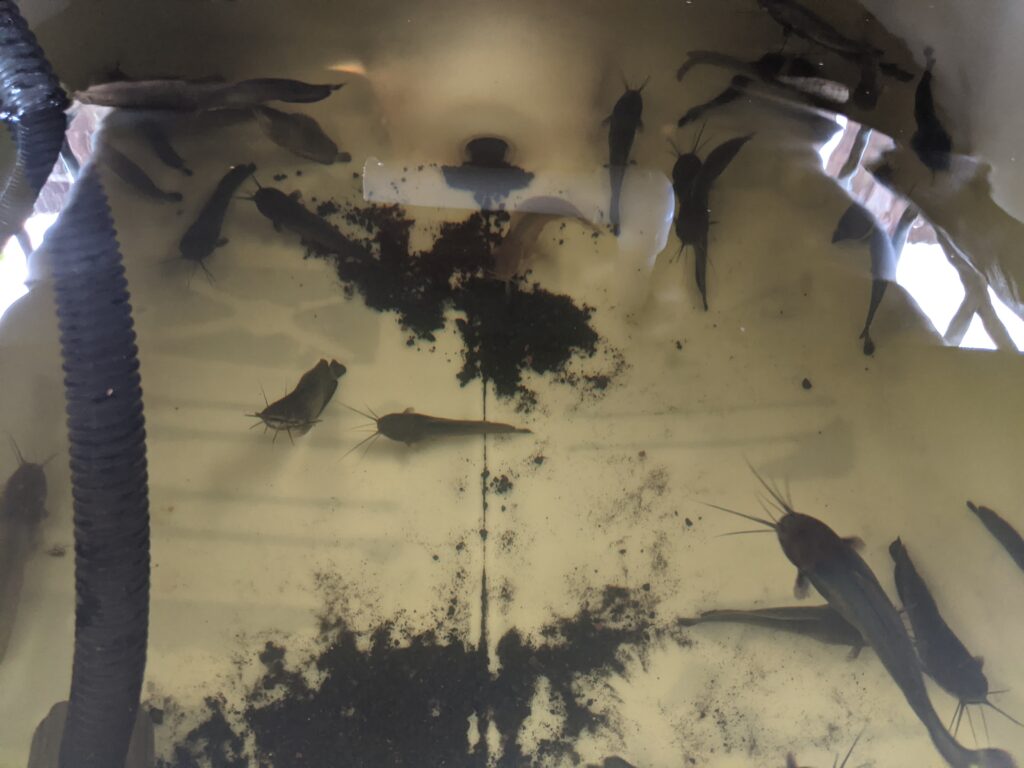

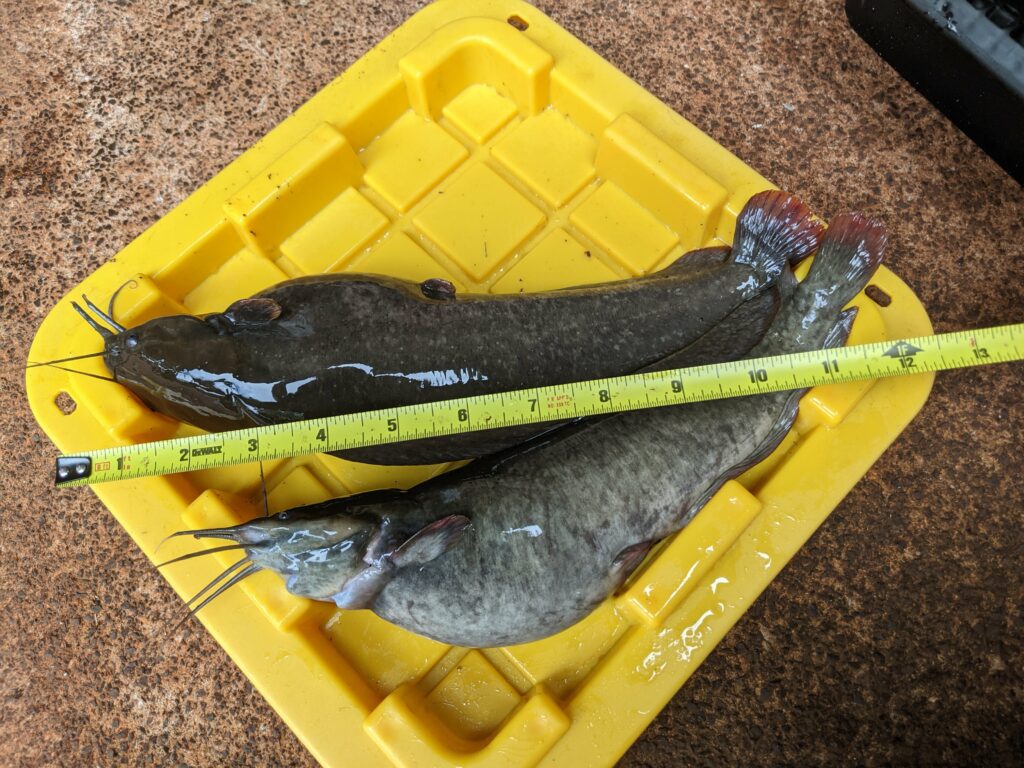

In hindsight, I think the best time to eat them is at 6 months. Between 6 and 9 months, the catfish were eating and pooping machines and only made my aquaponics system get dirtier faster, which meant I had to clean the filter often. They only grew an additional inch or two during this period and although their girth widened a bit, I feel like most of the energy from eating went towards reproduction rather than growth. Many of the females had eggs and it wasn’t worth it for me to wait for them to have babies since I could buy fingerlings off of Craigslist for $1.00 each. Plus, my aquaponics system was so dirty that I was eager to get them out of the tank. If I could do it all over again, I’d reduce the stock to 20 adult fish at 6 months and add 40 fingerlings. At 9 months I’d harvest the 20 adult fish and repeat the process at 6 months with the new stock of catfish.
Cooking walking catfish
Harvesting these catfish was difficult. For the queasy and rookies, this can be traumatizing because the catfish keep moving and jumping if you don’t hit them hard enough. Plus, their skulls are incredible hard so my Dad had to come and help out. The easiest method for us was to hold them down with a towel so they couldn’t slip and slide around. I ended up throwing a few straight into the freezer as that seemed to be a bit more merciful. These are given to Daisy periodically as a meal and she loves them.
For the recipes, I followed Life In Thailand’s YouTube cooking videos and the simple flour, salt, and pepper catfish was pretty tasty. The marinade could have been better, but he didn’t provide a recipe so I’ll blame that on miscommunication. My Thailand friends LOVE this catfish and keep asking me if I have anymore. They did taste a little “muddy” to me, but I honestly think that’s because my tank was overcrowded and the water was dirty. I’ve heard the same thing about tilapia and most people who raise tilapia themselves in clean water say it tastes great. If I ever do raise these walking catfish again, I’ll be sure to have a system in place and start harvesting them as soon as the water starts to get murky (around 6 months).
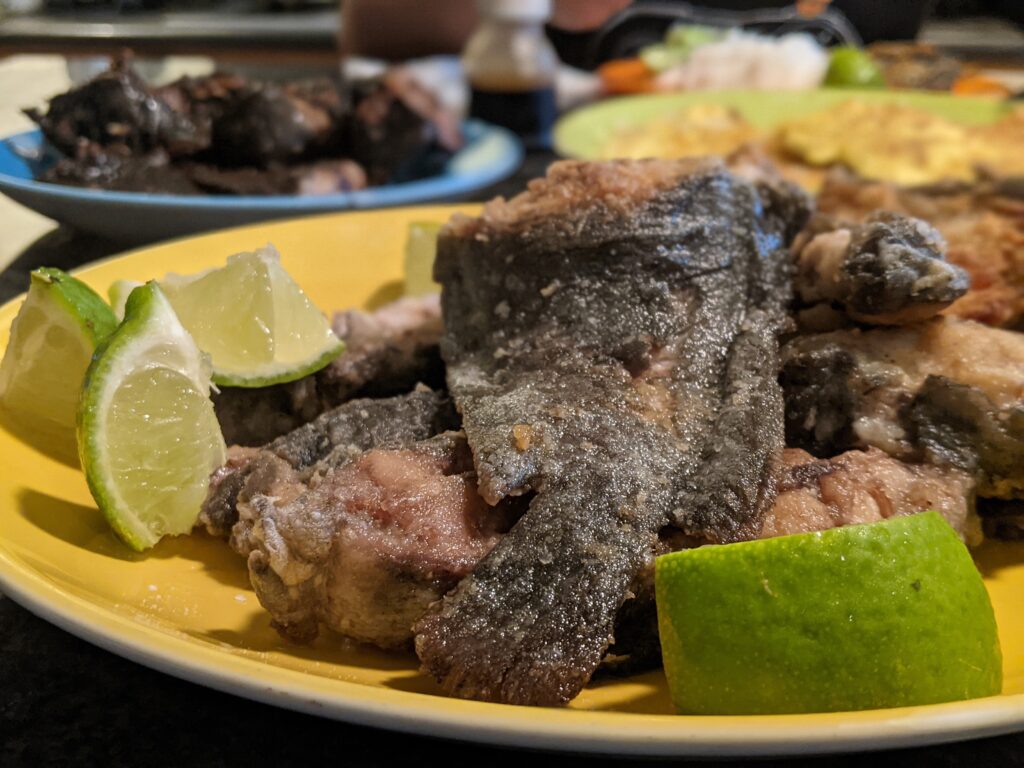
Would I raise walking catfish again?
What I love about these guys is that they’re at a good eating size in 5 to 6 months. Most aquaponic fish take about a year to get to a decent size. So if I could get a few great recipes and a cycle going where I never have more than 20 adult catfish in the IBC fish tank, then I would consider trying them out again.
By eating them before the 6-month mark, I cut down on their food intake and waste production so I save money on fish food and time spent not cleaning the filter. I’m currently trying this out with some nile tilapia, which are known to be the fastest-growing tilapia. The more common Hawaiian Gold tilapia are pretty to look at, but take about 2 to 3 years to get to a nice size. If it gets too difficult to eat them that fast, I can always toss a few into the freezer for Daisy to eat later. Her food bill adds up fast since she’s on a raw diet, so using walking catfish to supplement her meals helps me out a lot.
If you do decide to raise walking catfish or are thinking about adding them to your aquaponics system, I highly recommend building a really good radial flow settler. You’ll see IBC aquaponic systems with 5-gallon bucket radial flow settlers, but in my opinion, you’ll need something a lot stronger to manage walking catfish and their poop. I’ve tried filters with netting, shade cloth, and even sponges, but that just makes a huge mess and clogs up your filter in just a few days.
Let me know if this blog post answers your questions about raising walking catfish. If you’re in Hawaii, keep me posted on your experience!

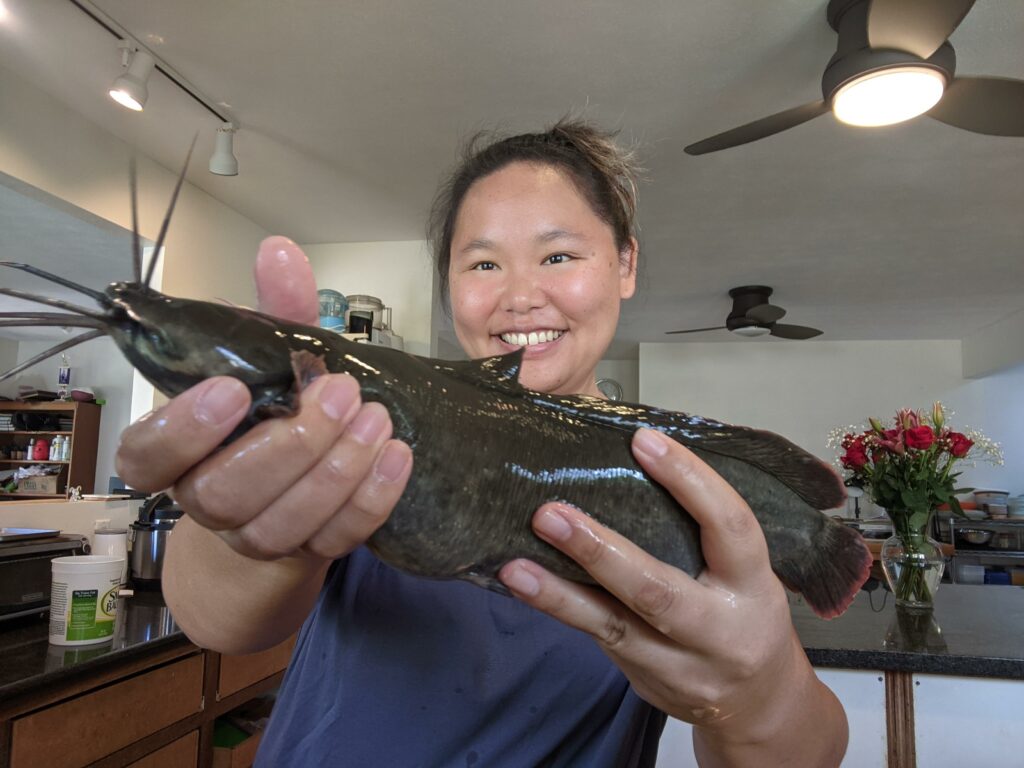
Hi, Amy! Love your post about walking catfish.
We just bout 2 acres with a 1500 gallon Aquaponics system in Kalaheo, Kauai. Are you on Kauai or know anyone here we can hire to help us get it up and running? Thank you.
Aloha Teresa! Congrats on the 2 acres – I’m jealous!! Kalaheo is a great place – not too far from Lihue, but not too close either. And wow! 1500 gallon system? That’s fantastic. Unfortunately, I’m out on Oahu and most aquaponic hobbyists are DIYers. Have you considered taking an aquaponic course? I think I’ve seen some advertisements before on and off. Try UH or the Big Island would be my suggestion. Aloha with love, Amy.
I am writing a paper on the history of Chinese catfish in Hawaii from an aquaculture perspective. I would like permission to use some of the photos from your blog.
I am writing a paper on the history of Chinese catfish in Hawaii from an aquaculture perspective. I would like permission to use some of the photos from your blog.